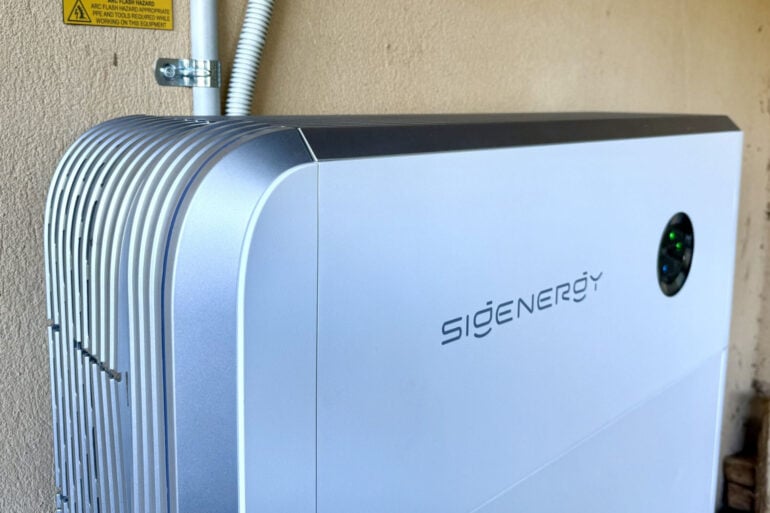As winter sets in and energy prices soar, a Sigenergy home battery has dramatically reshaped the way my household consumes power – with a valuable lesson on how much juice you can squeeze from the grid before something goes boom.
I’ve long been keen to make the leap to a solar home battery, after solar panels slashed my electricity bills in 2019 and then my Tesla Model Y eliminated petrol bills last year.
A home battery’s hefty price tag and long return on investment have held me back, keeping in mind that batteries slowly degrade, so they need to pay for themselves long before they’re ready to retire in around 15 years.
With the combination of falling battery prices and Australia’s new home solar battery rebate, I decided in June that it was time to make my move. Weighing up a few alternatives like Sungrow, BYD and Tesla’s Powerwall 3, I decided to go with a Sigenergy home battery.
Sigenergy won out because of its good reputation in terms of functionality and flexibility, plus its modular design, which allows installers to add extra battery capacity without significantly increasing costs.
As someone who’s worked from home for more than 20 years, my power bills are understandably higher than your average household. As such, I was considering a 16 kWh Sigenergy battery – combining two 8 kWh modules – which was already more affordable than a 13.5 kWh Tesla Powerwall 3.
When the quote for a third 8 kWh module was only a few thousand dollars more, I decided to go large with a 24 kWh Sigenergy system.
Thankfully, as a spreadsheet nerd, I had the data to analyse my hunch that bigger was better.
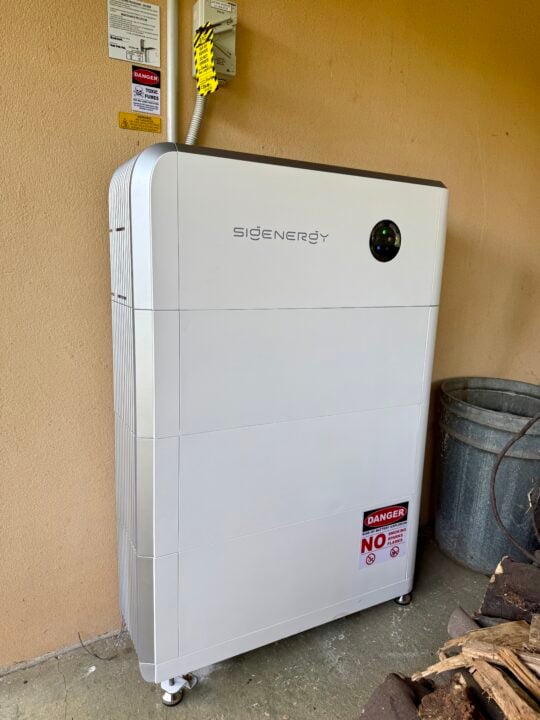
Crunching the numbers on a Sigenergy home battery
Every month, I export data from my solar inverter and electricity distributor to create fancy usage graphs. They helped with the battery buying decision and also offered some insight into how my power consumption has changed recently.
Things were going well power-wise until I got my Tesla at the start of last year, when I quickly realised that my solar wasn’t enough to slake its thirst.
My solar panels are hindered by the fact that I live in a valley, with a small, narrow roof that doesn’t let me place many panels facing north. In the middle of summer, my system maxes out at 5 kWh, producing 30 to 40 kW of power in a day. Yet peak output is more like 3 kWh in mid-winter, when I’m lucky to squeeze out 10 to 15 kW in a day if the sun decides to shine.
Meanwhile, the Tesla draws 7.7 kW when charging at the maximum rate. This means, even in the middle of summer, the solar isn’t enough to stop the car drawing on the grid unless I charge slowly.
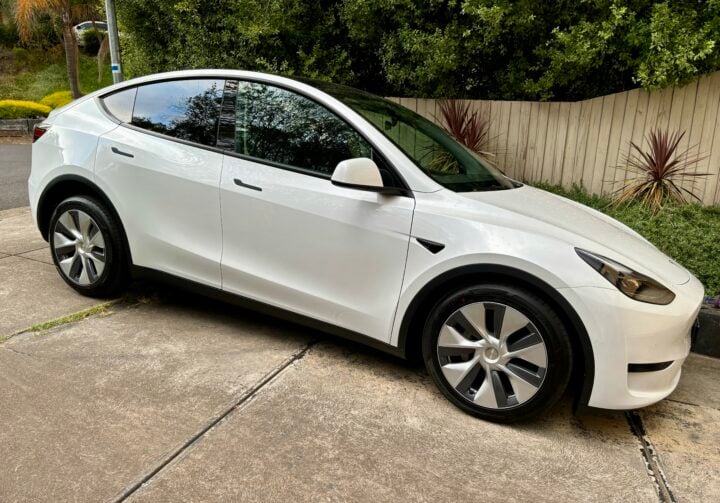
The solution was switching to a home electricity plan offering unlimited free green power between 11 AM and 2 PM every day. My wife drives to work most days, so I started charging the Tesla at lunchtime on the weekends, and it cost me practically nothing to run.
Even with a free power window, my graphs reveal I’ve still been buying an average of 14 kW per day in spring and autumn, creeping up over 20 kW in summer and winter. Using my electric air conditioning to heat in the winter, in order to rely less on my gas ducted heating, has pushed up my electricity consumption but lowered my overall energy bills.
Taking the plunge on a Sigenergy home battery
Recently, my wife changed jobs, and the longer drive is forcing me to top-up the car in the evenings. Plus, my daughter is now on her P plates and borrowing the car on weekends when I want to charge it for free.
All of this is driving up our electricity bill – my wife’s new job helps pay for our fancy home battery, but in return, it’s forced me to rethink our energy strategy.
As winter set in this year, my wife started her new job and my daughter borrowed the car on the weekends, we hit a record high of buying an average of 30 kW per day – costing me $11 per day, including the connection fee. At the same time last year, it was only 24 kW and $8.40.
Crunching the numbers on a Sigenergy battery, the return on investment was a little better on the 16 kWh option. Yet with the cost of electricity rising and our usage growing, stepping up from 16 kWh to a 24 kWh Sigenergy home battery definitely seemed like a smart move.
Keep in mind, experts recommend not running your home battery completely flat – which means I only have around 21 kWh to play with. Plus, that extra headroom will come in handy as the battery capacity slowly drops over time, they say to allow a 3 per cent drop per year. At the same time, the price of electricity keeps going up, meaning each kWh of battery capacity delivers you more savings each year.
When the plan goes sideways
Getting back to electricity plans, many EV owners opt for a plan that offers a cheap charging window between midnight and 6 AM – but in return demands a higher peak rate during the rest of the day. It’s known as “time-of-use pricing” rather than relying on a flat rate.
The numbers didn’t stack up on such a plan when I could mostly charge my Tesla for free on the weekends, but with my new charging schedule and battery, these plans now make a lot of sense for us.
This is where everyone has to decide for themselves how they want to use their home battery.
A common strategy is to get a battery that’s big enough to cover your evening peak use but not necessarily enough to get you through an entire day. People often use their average electricity consumption and the output of their solar panels to determine a good-sized battery.
This approach means you don’t need to spend as much upfront on battery capacity, but another approach is to spend more on a bigger battery and then use time-of-use pricing to your advantage.
Talking to my battery installer and joining the Sigenergy Australia Facebook group, I discovered that many battery owners take advantage of time-of-use pricing to make the most of the grid, rather than just relying on their solar to do the heavy lifting.
The idea is to completely fill your battery for free between 11 AM and 2 PM every day, which I can do thanks to the battery’s 10 kW inverter. With the assistance of solar, the aim of the game is to try to make all that power last until 11 AM the next day – or at least until midnight – so you never pay the higher peak rate.
This approach requires a bigger battery, but makes a lot of sense for me, considering I’m already on a time-of-use plan. Especially when I can’t squeeze a lot of excess power out of my solar to help fill the battery during the day on solar alone.
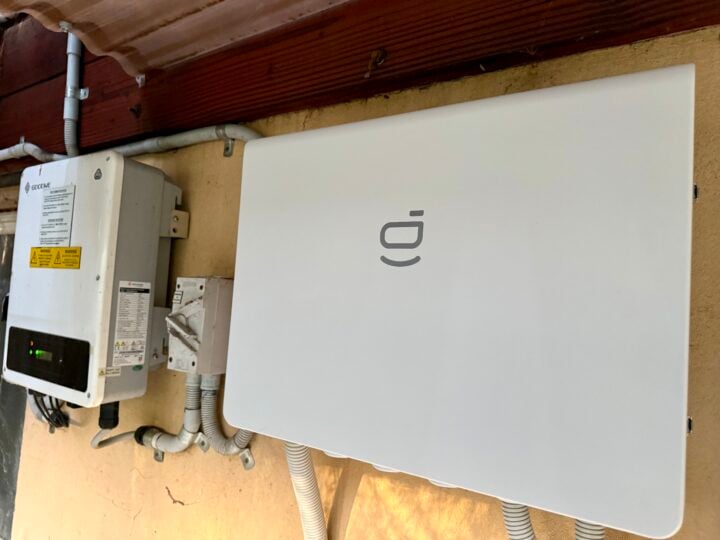
When the weather is mild in autumn and spring, this approach means I could potentially go days without paying a single cent for electricity to power the house, although I still might end up buying a bit to top-up the car. In the summer, the long sunny days will also reduce my reliance on the battery.
Of course, it’s tough in the middle of winter. That’s when you really benefit from topping up your battery and EV on the cheap between midnight and 6 AM. This lets you avoid paying peak morning rates when the heating comes on and you start your day.
Admittedly, relying heavily on the grid might seem hypocritical if you’re looking to help the environment as well as save money.
To address this concern, I still pay the extra green power fee for my electricity, ensuring my retailer buys that power from green sources. They assure me this also applies to the free power I consume. Plus, my solar helps top-up the battery during the day to reduce the amount of power I take from the grid.
All of this makes perfect sense when there’s such a glut of clean energy in the middle of the day. The power I’m pumping into my battery for free is the excess solar power that my neighbours are selling back to the grid for a pittance.
Getting to know my Sigenergy home battery
My battery was installed in mid-July and switched on at the end of the month after the electrical inspector gave it the all-clear. In the week or so since, I’ve already learned a lot about my new Sigenergy home battery and how to make the most of it.
To help manage the battery, Sigenergy offers a great mobile and web app that provides lots of flexibility when it comes to scheduling the battery’s behaviour during the day. I immediately set it to charge from the grid for free between 11 AM and 2 PM, then set about fine-tuning things over the next few days.
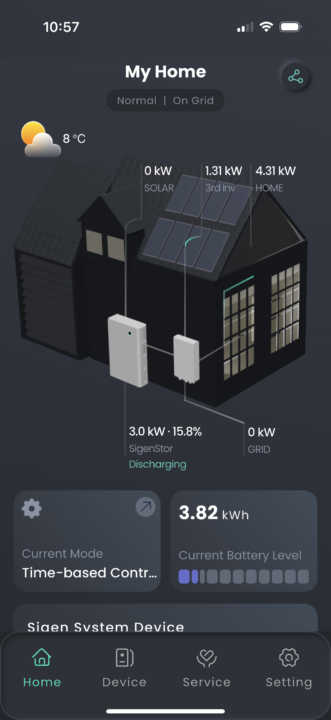
Unfortunately, the Sigenergy app’s advanced settings get rather confusing, because they’re full of jargon that often means the opposite of how it sounds. Drop-down explainers clarify some things, but there’s certainly work to be done in helping newbies find their feet.
Part of the problem is that Sigenergy is very keen to encourage new users to embrace its Sigen-AI Mode, which learns your household usage habits and then makes all the decisions to supposedly optimise performance and savings.
While Sigen-AI sounds like a smart idea, lots of people in the forums complain about it making dumb decisions. I decided to give it a miss, considering that I already have a pretty clear picture of what I want to achieve.
If you set up your own time-based schedules and custom controls, they become quite awkward to manage once you have a long list. There’s certainly work to be done in places to make the app more user-friendly.
With Sigenergy building a loyal following around the world, I was surprised to discover a dearth of decent setup guides online to help people dive into the advanced features. I expect it won’t be long before a Sigen Guru carves out a niche for themselves on social media. (Gratuitous plug: hit me up if you need a tech freelancer to assist with creating great content)
Optimising my Sigenergy home battery’s schedule
Winter is the torture test for trying to optimise your energy usage, and it’s a very unforgiving time of year to be mastering a home battery.
Having been thrown in the deep end, it only took two days to decide I should switch to a time-of-use electricity plan with a cheap early morning window for battery and EV top-ups, as well as the free lunchtime window that I already enjoyed.
At this point, you find yourself playing chicken with your battery and your EV, trying to top them up with just enough cheaper power in the early morning to avoid buying expensive power later in the day. Even a trickle of morning solar can help you make it to 11 AM without going bust, but that’s far from reliable in winter.
If you’re overly cautious, you end up buying too much cheap power you don’t need. Meanwhile, if you’re overly cavalier, you fall short and end up paying top dollar for peak power mid-morning. It’s smart to be a little cautious, considering that peak power is almost four times more expensive.
Thankfully, the Sigenergy app offers an excellent real-time breakdown of your household energy usage, including solar and battery stats, to help you strike the right balance. The battery was a big investment, and a bit of a stretch financially, so I really need to do everything I can to get the most out of it.
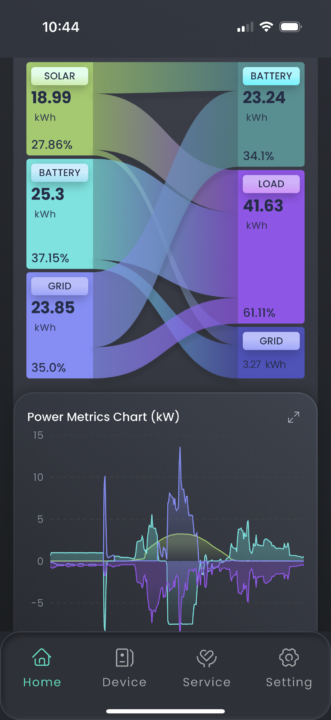
Watching the app like a hawk, on the first night, it became clear how much the dishwasher takes a toll on the battery. Now I’m determined to run it for free at lunchtime – a benefit of working from home – to help ensure the battery has enough juice left to make it through the night.
After trial and error, I’ve decided in winter it’s best to be conservative and top the battery back up to 50 per cent on the cheap before dawn, to be sure I make it to the 11 AM free charging window. Of course, that will be overkill at other times of the year, so I’ll reassess with the changing of the seasons.
I’m trying to err on the side of caution so I can establish set-and-forget settings, rather than needing to micro-manage it every day. Unfortunately, I can’t set the app to alert me mid-morning if the battery State of Charge (SoC) level drops under a certain threshold, and it looks like I won’t make it to 11 AM.
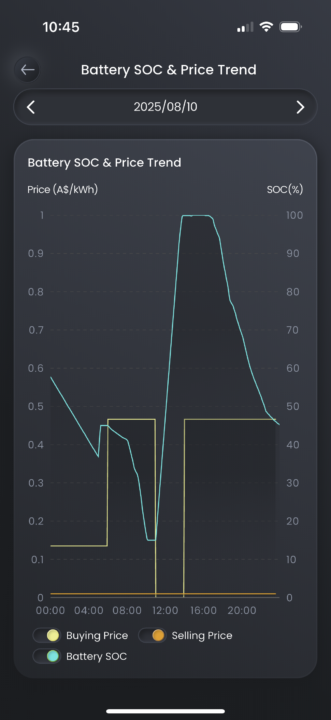
Similarly, I’m using Charge HQ to automatically top-up the Tesla to 45 per cent between midnight and 2 AM on weekdays, but only 30 per cent on weekends because it’s likely to get a big drink at lunchtime. In summer, I might use Charge HQ to put a little solar into the car in the late afternoons.
I’ve set the car to pull power straight from the grid to reduce wear and tear on the battery. Your own setup will depend on how your battery is connected to your EV charger – the Sigenergy can even act as a DC EV charger if you need it.
It’s a numbers game
As a stats nerd, I was very keen to drop all this data into a spreadsheet. So you can imagine my horror when I discovered how little of the app’s granular data can actually be exported.
My electricity distributor breaks down my power consumption and production into 30-minute increments, while my solar inverter spits out daily production figures. Thanks to some spreadsheet kung fu, this data paints a pretty detailed picture of what’s happening in my home.
In comparison, the Sigenergy data export only tells me about my solar performance – which I already know – and overall household daily consumption, which on its own is not very helpful. There’s no detail about how much power goes to and from the battery or how its SoC changes throughout the day.
Sigenergy reassures me that this is set to improve, but I’m still shocked that it didn’t launch with better data export features from day one, considering that this is a brand likely to appeal to spreadsheet nerds like myself.
For now, I’m manually copying how much the battery contributes to household power usage each day, so I can add it to my monthly graph. Without a more detailed breakdown, I can’t graph an average day to illustrate how the battery is doing the heavy lifting in the peak times.
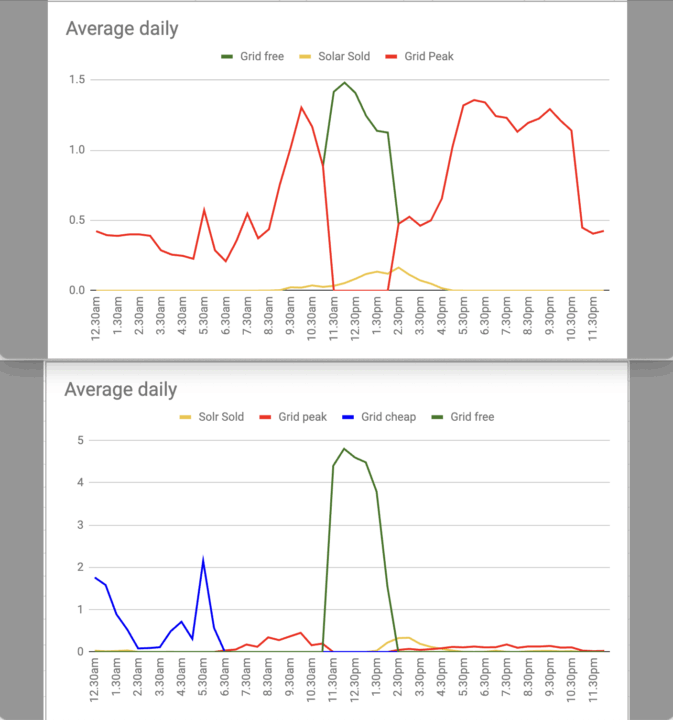
Compared to the previous month (top), in the days since the battery was switched on (bottom), you can see my reliance on the grid almost flatlines when electricity is expensive (red). It spikes when power is cheap (blue) and free (green) and I recharge the battery or top-up the car. You can also see I’ve exported a lot less solar (yellow) because it’s going into the battery instead. Unfortunately, without extra data from the battery, you can’t see exactly what it’s doing during the day.
The lack of battery SoC data will make it tough to model the best early morning top-up level for different seasons. It also makes it difficult to calculate savings and return on investment, so for now, I’m comparing my daily costs to what I was paying before I installed the battery and changed electricity plans.
My ROI calculations before buying the battery were based on it saving me at least $5 a day. After two weeks, I can see that I’ll easily achieve that in winter and probably summer, but it will be harder in the spring/autumn when I don’t spend as much on power to begin with.

My monthly usage graphs are pretty complicated; the main things to note are the red bar showing how much power I’m buying from the grid at the peak rate and the dollar amount of power I purchased that day (not including the daily connection fee). Green is the free power window in the middle of the day (which has grown due to filling the battery at lunchtime), and yellow is free power from my solar.
You can see the red peak usage plunge on August 2 when I switched to a plan with cheap power between midnight and 6 AM, with this new cheap power marked in blue. There’s still the occasional spot of red where I’ve played chicken with the battery level and not quite made it to 11 AM.
At this point, I’m only spending about $10 a week on power; one day it was only 38 cents. You can see that in total, I’m still using about the same amount of power as before, but in the two weeks before the battery was switched on, I spent $80 and $95 on electricity. It was a similar story last month.
So at this point, I’m saving roughly $10 a day, which is more than I expected and should compensate for lower savings in autumn and spring.
A watt too far
I was already getting impressive results by the first weekend, when it was time to finally hammer that free charging window by filling the battery while also charging the Tesla parked in the driveway.
Come 11 AM Saturday, I let rip – the battery and EV started charging at maximum while the heating, dishwasher, washing machine, and dryer were running, along with the bathroom heater. I was very excited to be pulling down more than 20 kW from the grid, running around the house shouting “Twenty! One! Point! One! Kilowatts!” like Doc Brown.
Then I made myself a coffee to celebrate. Boom!
Well, thankfully, not actually boom. More like a flurry of smartphone alerts as I tripped my switchboard’s main isolator grid switch – losing my connection to the street while the house seamlessly switched to battery backup mode. Only the heating and Tesla charger lost power, as those circuits are not backed up.
Consulting the Sigenergy Australia Facebook group brains trust, it soon became clear that I’d pulled down way more power than my line to the street could handle. My main isolator grid switch tripped to avoid far more serious consequences.
To avoid a repeat, I manually set the grid import limit to 16.5 kW in my battery’s charging schedule, which was enough to not trip the fuse on Sunday.
During the following week, I learned that I need to keep an eye on the amps more than the kilowatts. Watching the app after 11 AM on the next Saturday morning, I could see 16.5 kW was still pushing things over the 63-amp limit my connection to the grid can sustain.
After some trial and error, I decided 14.8 kW is the magic number. At this point, as I turn on more power-hungry appliances around the house, I can see the battery drawing less from the grid to keep the total load around 63 amps.
Changing the battery settings every few minutes and watching the results, it also became clear that the Sigenergy app can be sluggish and temperamental at times – even when the unit is connected via Ethernet rather than Wi-Fi. It’s frustrating that controlling the battery requires going through the internet, rather than connecting to it directly across my home network.
I also learned that the system default limit for drawing power from the grid hadn’t been set on the backend, so on that first Saturday, it didn’t know when to hold back. The installer suggested being overly conservative and dialling it back to 13 kW, but I’ll stick with 14.8 kW for a while – if I put it too low, there’s a risk the battery won’t fully recharge in the three-hour free window.
I didn’t mind running a few tests on a Saturday morning, but, to be honest, it all sounds like more drama than your average punter wants to go through when breaking in a new battery. I expect installers will start setting more conservative power limits by default, and offering more detailed usage tips to avoid such dramas, even if it means that customers aren’t quite squeezing the most out of their grid connection.
All up, I’m very happy with my Sigenergy home battery, and it looks like a great long-term investment. Mastering it is still a work in progress, frustratingly hampered by the lack of detailed export data.
To be fair, the complexity is mostly my fault because I’m trying to juggle a time-of-use electricity plan and play chicken with the battery level in the mornings, rather than just be happy covering the evening peak usage with a smaller battery. Once I find the best defaults, it’ll be a set-and-forget solution that only needs to be tweaked with the changing of the seasons.
Everyone needs to determine their own home battery strategy but, if you’re smart about it, it’s a great way to slash your growing power bills.
